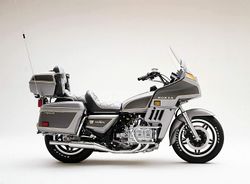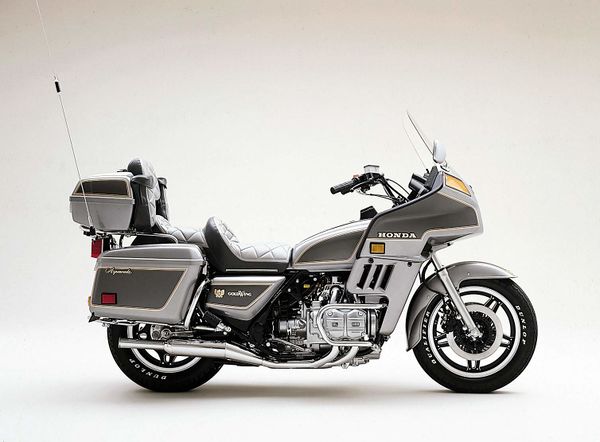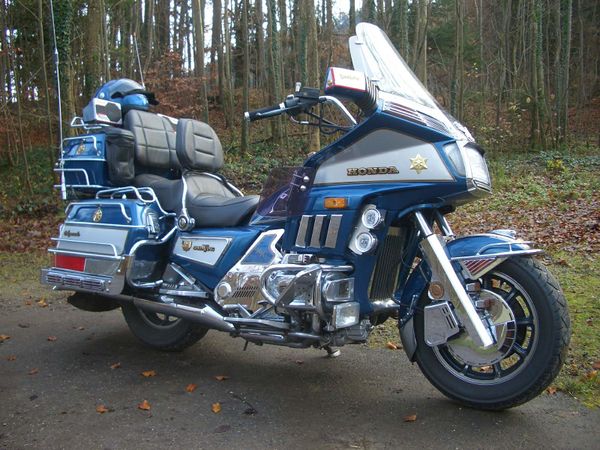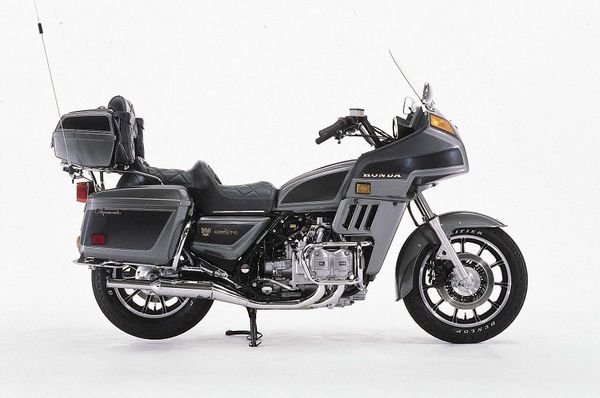Honda GL1100 Gold Wing Aspencade
 |
|
| Honda GL1100 Gold Wing Aspencade | |
| Manufacturer | |
|---|---|
| Production | 1982-83 |
| Class | Tourer |
| Engine | Four stroke, opposed boxer four cylinders, SOHC, 2 valves per cylinder |
| Compression ratio | 9.2:1 |
| Top Speed | 215.6 km/h / 134 mph |
| Ignition | Electronic |
| Transmission | 5 Speed |
| Frame | Steel, full duplex cradle |
| Suspension | Front: Adjustable telehydraulic fork. Rear: Swinging arm with adjustable shocks absorbers. |
| Brakes | Front: 2 x 232 mm discs, 2 piston calipers Rear: Single 250 mm disc ,1 piston caliper |
| Front Tire | 110/90-19 |
| Rear Tire | 130/90-17 |
| Wheelbase | 1605 mm / 63.2 in. |
| Seat Height | 795 mm / 31.3 in. |
| Weight | 310 kg / 683 lbs (dry), 347 kg / 764 lbs (wet) |
| Recommended Oil | Honda GN4 10W-40 |
| Fuel Capacity | 20 Liters / 5.3 US gal |
| Manuals | Service Manual |
It could reach a top speed of 215.6 km/h / 134 mph.
Engine[edit | edit source]
The engine was a Liquid cooled cooled Four stroke, opposed boxer four cylinders, SOHC, 2 valves per cylinder. The engine featured a 9.2:1 compression ratio.
Chassis[edit | edit source]
It came with a 110/90-19 front tire and a 130/90-17 rear tire. Stopping was achieved via 2 x 232 mm discs, 2 piston calipers in the front and a Single 250 mm disc ,1 piston caliper in the rear. The front suspension was a Adjustable telehydraulic fork. while the rear was equipped with a Swinging arm with adjustable shocks absorbers.. The GL1100 Gold Wing Aspencade was fitted with a 20 Liters / 5.3 US gal fuel tank. The bike weighed just 310 kg / 683 lbs. The wheelbase was 1605 mm / 63.2 in. long.
Photos[edit | edit source]
Overview[edit | edit source]
Honda GL 1100 Gold Wing Aspencade
It was unfair, no doubt about it. We'd set off aboard the 750s featured in this month's comparison test, five of the most sporting bikes to come along since the invention of asphalt. Fast, agile, and high-strung, this squadron of bend-bombers was almost unaffected by the lightweight luggage and small fairings we slapped on prior to leaving. We were searching for the curviest road in California. So what did we choose as our chase bike, pace bike, and photo bike? A bike that seemed to be just the opposite of the sporty 750s, a Honda Gold Wing. This was not just a standard GL1100 either. It wasn't even the Interstate version, which comes with what seems like every accessory imaginable for touring: a full fairing with height-adjustable windshield, storage pockets, headlight adjustment knob, vents, QH headlamp, front and rear crashbars, adjustable seat, detachable trunk big enough for two helmets, and saddelbags with lift-out packing bags. Our 750-chaser, the Aspencade, is the latest addition to the GL1100 family, and it manages to out-dress even the Interstate. With its tuck-and-roll upholstery, matching stash bags on the front of the trunk, two-tone silver (or brown) paint job, standard AM-FM stereo radio with handlebar tuning and volume control, clock, voltmeter, cockpit-controlled air suspension, and even a vanity mirror in the trunk lid, it exudes the unhurried, luxurious air of a Rolls-Royce. It incorporates almost every opulent touch the superhighway traveler could want, and what's missing (with the exception of a color-coordinated trailer and a hitch) can probably be found on the options list, which includes an intercom system, cassette player, and CB radio. In short, the Aspencade is just the bike you'd want for traveling to and being seen at its namesake, the Aspencade motorcycle rally. But it wouldn't be your first choice for chasing five adrenaline-crazed speed freaks down California's twistiest roads, especially if every luggage container aboard was stuffed with tools, cameras, and other necessities. Nonetheless, that was the job assigned to this latest version of Honda's horizontally-opposed four. However, we did give it a day's grace. One member of our sextet of testers had to take care of some last-minute details in Los Angeles and left with the Aspencade five hours after the rest of the group departed aboard the 750s. Naturally, the lone late-departer stuck to the fast, straight highways instead of using the same back roads the 750s had taken. The GL1100 is most at home on the big, wide expanses of concrete or asphalt, and the full-dress Interstate and Aspencade versions are even more so. On the superslab, all those pieces fit perfectly. The big fairing chops those gale-force winds down to a gentle breeze; only around your helmet, where there is some buffeting, does the wind intrude at all. Thus, the rider remains warm and relaxed. With the introduction of the V45, the GL1100 can no longer claim to be motorcycling's smoothest engine. However, no rider is ever likely to complain or even thinkabout vibration. Liquid-cooling, shaft drive, and the vacuum-advanced electronic ignition make the drive train reliable and fiddle-free, and what little maintenance the rider will have to do is simplified by screw-type valve adjustment and the simple two-valves-per-cylinder system. All wrapped up in its fairing and luggage, the GL1100 isn't even as quick as the 750s at the dragstrip. But it still produces the kind of power a tourer needs. No-downshift passes are quick and easy; a twist of the throttle is all that's needed. Its substantial weight (764 pounds wet) is largely responsible for its poor performance as a sprinter, but it means additional weight doesn't suddenly make it seem slow. Even with a passenger and a full load, that strong mid-range power comes through with a burst of speed during a top-gear pass. The ratios of the top three gears in the GL's transmission and the final-drive ratio have been raised (lowered numerically) this year to make the GL even smoother and less hurried-feeling, but it hasn't made much of a dent in the Wing's highway-speed acceleration potential. It also hasn't made any improvement in the crunchy shifting. You still have to shift the five-speed with authority or you'll get more grind than gear. Another traditional drive-train problem, clutch grab, surfaced after the Gold Wing's dragstrip session, but probably won't trouble riders who use the bike more conventionally. The gear-ratio changes certainly didn't hurt fuel mileage. We averaged 39.4 mpg, which is surprisingly high considering our occasionally cruel and often unusual punishment of the bike. At fairly steady highway speeds, the Aspencade regularly turned in 45 to 50 mpg. Both the Interstate and the Aspencade are extremely spacious. Two riders, even wide ones, fit comfortably on the semi-bucket seat. Passengers commented that the backrest on the trunk provided an extra degree of comfort and security, and the seat's fore-aft adjustability (through a range of approximately 1.6 inches) allows rider and passenger an extra chance to find a comfortable seat-peg-bar relationship. Most of our testers preferred the seat in its forward setting. With the Aspencade's fairing to divert the wind, we were happy with the high, wide handlebar, which would have been uncomfortable without good wind-protection. Despite its large step, the saddle itself is fairly roomy, providing enough latitude for the rider to shift his position. Padding is more than adequate, but the shape could be improved. The rider's section is slightly crowned, especially at the front, to make it easier for short legs to reach the ground. This shape does not fit the average American buttocks and induces some of the dreaded butt-skin stretch after a few hours. The upholstery may also aggravate this. The problem can be largely avoided by sitting as far rearward as possible. The seat is better than average, but it could be better still, and we think that the world's leading touring machine deserves a saddle to match. Unless you're limp-wristed, like staffers Hill and Ford, and suffer from throttle fatigue, you won't find any other discomforts on the open road. You'll probably bash your shins on the engine guards a few times at stops, but everyone seems to adjust to this problem rapidly and learns how to avoid the crashbar when putting his feet down. Contributing to the Gold Wing's comfort is an excellent ride. Like the other GLs, the Aspencade has air-assisted suspension at both ends. Combined with the suspension's stiction-reducing features, the progressiveness of air suspension provides excellent bump absorption and allows the rider to adjust for the wide variations in load which are likely with the Aspencade. Unlike the other Gold Wings, the Aspencade carries its own electric air-compressor to fill the suspension. The compressor is located in the cavity at the top of the dummy fuel tank. (The real 5.3-gallon tank is under the seat.) With the hoses that link it to the two suspension systems, the compressor uses most of the dummy-tank storage space found on other GL1100 models. The system has its own filter/dehumidifier to make sure that only clean, dry air is pumped into the suspension. A panel atop the dummy tank houses the control buttons and a gauge which monitors pressure. Colored bands on the gauge face indicate suggested pressure in front (14 to 21 psi) and rear (28 to 57 psi) suspensions. Pressing the "front" or "rear" button to the left of the gauge opens the appropriate system and its hoses to a connecting chamber fed by the compressor. Pushing the "up" button to the right of the gauge activates the compressor, which pumps air into the chamber and, if you're pressing one of the left-side buttons, into one end's suspension. Pressing the "down" button bleeds air out of the system. It takes about five seconds to completely inflate an empty rear-suspension system. The suspension should be checked and adjusted when the bike is on its centerstand, and the compressor only works when the ignition switch is in the "P" (park) position. A Honda spokesman told us this arrangement prevents the rider from incorrectly adjusting his suspension while riding and keeps the compressor from draining the battery if somebody fiddles with it when the bike is parked. Source Motorcyclist 1982
| Make Model | Honda GL 1100 Gold Wing Aspencade |
|---|---|
| Year | 1982-83 |
| Engine Type | Four stroke, opposed boxer four cylinders, SOHC, 2 valves per cylinder |
| Displacement | 1085 / 66.2 cub in. |
| Bore X Stroke | 76 x 61.4 mm |
| Compression | 9.2:1 |
| Cooling System | Liquid cooled |
| Induction | 4 x 30 mm Keihin carbs. |
| Ignition | Electronic |
| Starting | Electric |
| Max Power | 59 kW / 81 hp @ 7000 rpm |
| Max Torque | 88 Nm / 9.0 kgf-m / 64.9 lb-ft. @ 5500 rpm |
| Transmission | 5 Speed |
| Final Drive | Shaft |
| Rake | 29.2° |
| Trail | 132 mm / 5.2 in. |
| Front Suspension | Adjustable telehydraulic fork. |
| Front Wheel Travel | 148 mm / 5.8 in. |
| Rear Suspension | Swinging arm with adjustable shocks absorbers. |
| Rear Wheel Travel | 80 mm / 3.1 in. |
| Front Brakes | 2 x 232 mm discs, 2 piston calipers |
| Rear Brakes | Single 250 mm disc ,1 piston caliper |
| Front Tire | 110/90-19 |
| Rear Tire | 130/90-17 |
| Frame | Steel, full duplex cradle |
| Dimensions | Length: 2340 mm / 92 in. |
| Wheelbase | 1605 mm / 63.2 in. |
| Seat Height | 795 mm / 31.3 in. |
| Dry Weight | 310 kg / 683 lbs |
| Wet Weight | 347 kg / 764 lbs |
| Fuel Capacity | 20 Liters / 5.3 US gal |
| Consumption Average | 6.0 L/100 km / 16.8 km/l / 39.4 mpg |
| Standing ¼ Mile | 12.9 sec / 153.9 km/h / 95.6 mph |
| Top Speed | 215.6 km/h / 134 mph |
| Manuals | Clarion Type I Radio Installation Manual (5.2 MB) Clarion Type II CB Intercom Cassette Installation Manual (1.6 MB) Clarion Type II Radio Installation Manual (525 KB) Clarion Type II Radio Operating Manual (2.1 MB) Cycle Innovations Installation and Troubleshooting Guide (10.4 MB) Clarion Type II Multichanger Audio Pinouts (29 KB) features and specifications (200 KB) GL1000 and GL1100 Starter Rebuild Manual (169 KB) GL1100 1979-81 Haynes Owners Workshop Manual (27.1 MB) GL1100 80-82 Honda Parts Manual (1.6 MB) GL1100 80-83 Parts Manual (5.4 MB) GL1100 Hondaline Fairing Install (1.3 MB) GL1100 Interstate 1982 Color Schematic (463 KB) GL1100 Interstate 1983 Color Schematic Diagram (500 KB) GL1100 Standard 1980 - 1982 Color Schematic Diagram (620 KB) GL1100 Standard 1983 Color Schematic Diagram (517 KB) |
External Links[edit | edit source]
- http://goldwingchrome.com/Manuals/GL1100/Honda%20Goldwing%20GL1100%20Interstate%201983%20Color%20Schematic.jpg
- http://goldwingchrome.com/Manuals/GL1100/Honda%20Goldwing%20Clarion%20Type%20II%20Radio%20Installation%20Manual.pdf
- http://goldwingchrome.com/Manuals/GL1100/Honda%20Goldwing%20GL1100%20Interstate%201980%20to%201982%20Color%20Schematic.jpg
- http://goldwingchrome.com/Manuals/GL1100/Honda%20Goldwing%20GL1100%201980%20to%201983%20Parts%20Manual.pdf
- http://goldwingchrome.com/Manuals/GL1100/Honda%20Goldwing%20GL1100%20Standard%201980%20to%201982%20Color%20Schematic.jpg
- http://goldwingchrome.com/Manuals/GL1100/HondaHaynesManual.pdf
- http://goldwingchrome.com/Manuals/GL1100/Honda%20Goldwing%20GL1100%201980%20to%201982%20Honda%20Parts%20Manual.pdf
- http://goldwingchrome.com/Manuals/GL1100/Honda%20Goldwing%20GL1100%20Hondaline%20Fairing%20Installation%20Manual.pdf
- http://goldwingchrome.com/Manuals/GL1100/Honda%20Goldwing%20Clarion%20Type%20I%20Radio%20Installation%20Manual.pdf
- http://goldwingchrome.com/Manuals/GL1100/Cycle%20Innovations%20Installation%20and%20Troubleshooting%20Guide.pdf
- http://goldwingchrome.com/Manuals/GL1100/Honda%20Goldwing%20Clarion%20Type%20II%20CB%20Intercom%20Cassette%20Installation%20Manual.pdf
- http://goldwingchrome.com/Manuals/GL1100/Honda%20Goldwing%20Specifications.pdf
- http://goldwingchrome.com/Manuals/GL1100/Honda%20Goldwing%20GL1100%20Standard%201983%20Color%20Schematic.jpg
- http://goldwingchrome.com/Manuals/GL1100/Honda%20Goldwing%20Clarion%20Type%20II%20Radio%20Operating%20Manual.pdf
- http://goldwingchrome.com/Manuals/GL1100/Honda%20Goldwing%20GL1000%20GL1100%20Starter%20Rebuild.pdf
- http://goldwingchrome.com/Manuals/GL1100/Honda%20Goldwing%20GL1100%20Audio%20Pinouts.gif


